
|
You entered: image
 Sojourner On Mars
Sojourner On Mars
7.07.1997
The six wheeled robot rover Mars Sojourner rolled onto the martian surface on July 5th (Sol 2) at about 10:40 PM Pacific Daylight Time. This image confirms that its descent down the lander's rear deployment ramp was successful.
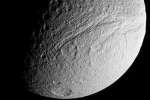 Ithaca Chasma: The Great Rift on Saturns Tethys
Ithaca Chasma: The Great Rift on Saturns Tethys
24.06.2008
What created the Great Rift on Saturn's moon Tethys? No one is sure. More formally named Ithaca Chasma, the long canyon running across the right of the above image extends about 2,000 kilometers long and spreads as much as 100 kilometers wide.
 Ultraviolet Andromeda
Ultraviolet Andromeda
17.09.2009
Taken by a telescope onboard NASA's Swift satellite, this stunning vista represents the highest resolution image ever made of the Andromeda Galaxy (aka M31) - at ultraviolet wavelengths. The mosaic is composed of 330 individual images covering a region 200,000 light-years wide.
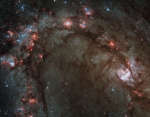 M83s Center from Refurbished Hubble
M83s Center from Refurbished Hubble
15.11.2009
What's happening at the center of spiral galaxy M83? Just about everything, from the looks of it. M83 is one of the closest spiral galaxies to our own Milky Way Galaxy and from a distance of 15 million light-years, appears to be relatively normal.
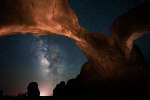 Three Arches Above Utah
Three Arches Above Utah
24.05.2011
How many arches can you count in the above image? If you count both spans of the Double Arch in the Arches National Park in Utah, USA, then two. But since the above image...
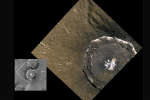 MESSENGER s Degas View
MESSENGER s Degas View
22.06.2011
Now imaging inner planet Mercury from orbit, the MESSENGER spacecraft wide angle camera has returned this impressive color view of Degas Crater, with a full resolution of 90 meters per pixel. Named...
 Crescent Saturn
Crescent Saturn
6.07.2019
Saturn never shows a crescent phase -- from Earth. But when viewed from beyond, the majestic giant planet can show an unfamiliar diminutive sliver. This image of crescent Saturn in natural color was taken by the robotic Cassini spacecraft in 2007.
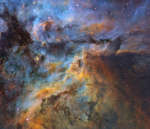 South of Carina
South of Carina
21.05.2020
With natal dust clouds in silhouette against glowing atomic gas, this colorful and chaotic vista lies within one of the largest star forming regions in the Milky Way galaxy, the Great Carina Nebula.
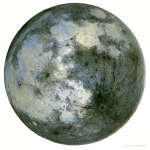 Moon in Inverted Colors
Moon in Inverted Colors
7.03.2022
Which moon is this? It's Earth's moon -- but in inverted colors. Here, the pixel values corresponding to light and dark areas have been translated in reverse, or inverted, producing a false-color representation reminiscent of a black and white photographic negative.
 A Flyby View of Ganymede
A Flyby View of Ganymede
25.10.1996
This is what it would look like to fly over the surface of Jupiter's moon Ganymede. NASA's robot spacecraft Galileo recently approached only 6000 miles from this frozen ice-ball of a moon. The above image is a digital reconstruction from two images taken during this flyby.
|
January February March April May June July |
|||||||||||||||||||||||||||||||||||||||||||||||||